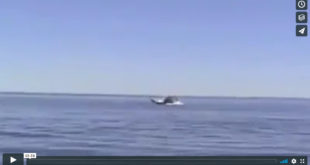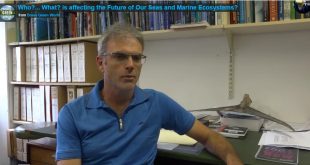This video is from the cop19 event in warsaw and features the scripps institute of oceanography speaker Natalya Gallo talking to us about global ocean DE oxygenation zones. The three major negative effects of climate warming on our oceans is an increase of ocean acidity, heating of the ocean and a loss of oxygen.
Oxygen concentrations in both the open ocean and coastal waters have been declining since at least the middle of the 20th century. This oxygen loss, or deoxygenation, is one of the most important changes occurring in an ocean increasingly modified by human activities that have raised temperatures, CO2 levels, and nutrient inputs and have altered the abundances and distributions of marine species. Oxygen is fundamental to biological and biogeochemical processes in the ocean. Its decline can cause major changes in ocean productivity, biodiversity, and biogeochemical cycles. Analyses of direct measurements at sites around the world indicate that oxygen-minimum zones in the open ocean have expanded by several million square kilometers and that hundreds of coastal sites now have oxygen concentrations low enough to limit the distribution and abundance of animal populations and alter the cycling of important nutrients.
As plastic waste pollutes the oceans and fish stocks decline, unseen below the surface another problem grows: deoxygenation. Breitburg et al. review the evidence for the downward trajectory of oxygen levels in increasing areas of the Open Ocean and coastal waters. Rising nutrient loads coupled with climate change each resulting from human activities are changing ocean biogeochemistry and increasing oxygen consumption.
This results in destabilization of sediments and fundamental shifts in the availability of key nutrients. In the short term, some compensatory effects may result in improvements in local fisheries, such as in cases where stocks are squeezed between the surface and elevated oxygen minimum zones. In the longer term, these conditions are unsustainable and may result in ecosystem collapses, which ultimately will cause societal and economic harm.
It is a known fact that warm water holds less oxygen yet our oceans continue to heat up. You can even take a look on Google Ocean to see where the mot damaged areas are.
Our Biological oceanography student helps talk us through the areas which are warmest and shows us a map of the naturally occurring low oxygen zones. This video is very enlightening with regards to waking up to the consequences of many ocean warming areas. There is a massive decrease in tuna in certain parts of the world alongside the decrease of many other types of fish which is a great shame. The student reminds us how a 1degree increase in global ocean temperature can have a big impact on oxygen. A 1 degree warming in the ocean results in a 10% increase in hypoxic areas and tripling the areas of suboxic zones (deaustch et al).There are profound consequences such as reduced diversity, altered animal behaviour, fisheries declined, redistribution of communities and altered biochemical cycles.
Oxygen depletion zones in the ocean are very tightly correlated with warming periods. The students from the SCRIPPS University are actively trying to communicate their research to more of a public audience. The research done at this university is very profound and needs more recognition so please support by commenting and reading what’s done on the brilliant SCRIPPS website which is in the link below.
This is a very informative video that is definitely worth a watch.
Links: https://www.google.com/maps/about/behind-the-scenes/streetview/treks/oceans/ , http://science.sciencemag.org/content/359/6371/eaam7240 , https://scripps.ucsd.edu/ , https://www.scientificamerican.com/article/ocean-dead-zones/ , https://www.scientificamerican.com/article/oceanic-dead-zones-spread/
By Alex Mitchison
 Mother Channel Environmental, climate change news and media.
Mother Channel Environmental, climate change news and media.



